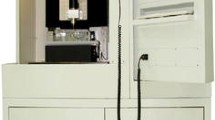Abstract
Electrochemical micromachining (EMM) could be used as one the best micromachining technique for machining electrically conducting, tough and difficult to machine material with appropriate machining parameters combination. This paper attempts to establish a comprehensive mathematical model for correlating the interactive and higher-order influences of various machining parameters, i.e. machining voltage pulse on/off ratio, machining voltage, electrolyte concentration, voltage frequency and tool vibration frequency on the predominant micromachining criteria, i.e. the material removal rate and the radial overcut through response surface methodology (RSM), utilizing relevant experimental data as obtained through experimentation. Validity and correctiveness of the developed mathematical models have also been tested through analysis of variance. Optimal combination of these predominant micromachining process parameters is obtained from these mathematical models for higher machining rate with acuuracy. Considering MRR and ROC simultaneously optimum values of predominant process parameters have been obtained as; pulse on/off ratio, 1.0, machining voltage, 3 V, electrolyte concentration, 15 g/l, voltage frequency of 42.118 Hz and tool vibration frequency as 300 Hz. The effects of various process parameters on the machining rate and radial overcut are also highlighted through different response surface graphs. Condition of machined micro-holes are also exhibited through the SEM micrographs in this paper. Pulse voltage pattern during electrochemical micromachining process has been analyzed with the help of voltage graphs. Irregularities in the nature of pulse voltage pattern during electrochemical micromachining have been observed and the causes of these irregularities are further investigated.
Similar content being viewed by others
References
Rajurkar KP, Zhu D, McGeough JA, Kokaz J, De Silva A (1999) New development in electrochemical machining. CIRP Ann 48(2):567–579
Datta M, Romankiw LT (2000) Application of chemical and electrochemical micromachining in electronics industries. J Electrochemist Soc 136(6)285C–292C
Ebeid SJ, Hewidy MS, El-Taweel TA, Youssef AH (2004) Towards higher accuracy for ECM hybridized with low-frequency vibrations using the response surface methodology. J Mater Process Technol 149:432–438
Kurita T, Chikamori K, Kubota S, Hattori M (in press) A study of three-dimensional shape machining with an EC μM system. Int J Mach Tool Manuf
Rajurkar KP, Zhu D, McGeough JA, Kozak J, De Silva A (1999) New developments in electro-chemical machining. CIRP Ann 48(2):567–579
Bhattacharyya B, Sorkhel SK (1999) Investigation for controlled ellectrochemical machining through response surface methodology-based approach. J Mater Process Technol 86:200–207
Bhattacharyya B, Munda J, Malapati M (2004) Advancement in electrochemical micro-machining. Int J Mach Tools Manuf 44:1577–1589
van Osenbruggen C, de Regt C (1985) Electro-chemical micromachining. Philips Tech Rev 42:22–32
Bhattacharyya B, Munda J (2003) Experimental investigation on the influence of electrochemical machining parameters on machining rate and accuracy in micromachining domain. Int J Mach Tools Manuf 43:1301–1310
Li Yong, Zheng Yunfei, Yang Guang, Peng Liangqiang (2003) Localized electrochemical micromachining with gap control. Sensore and Actuators A 108:144–148
Chikamori K (1998) Possibilities of electrochemical micromachining. Int J Jpn Soc Precis Eng 32(1):37–38
Bhattacharyya B, Malapati M, Munda J, Sarkar A (in press) Influence of tool vibration on machining performance in electrochemical micro-machining of copper. Int J Mach Tool Manuf
Author information
Authors and Affiliations
Corresponding author
Rights and permissions
About this article
Cite this article
Munda, J., Bhattacharyya, B. Investigation into electrochemical micromachining (EMM) through response surface methodology based approach. Int J Adv Manuf Technol 35, 821–832 (2008). https://doi.org/10.1007/s00170-006-0759-0
Received:
Accepted:
Published:
Issue Date:
DOI: https://doi.org/10.1007/s00170-006-0759-0




